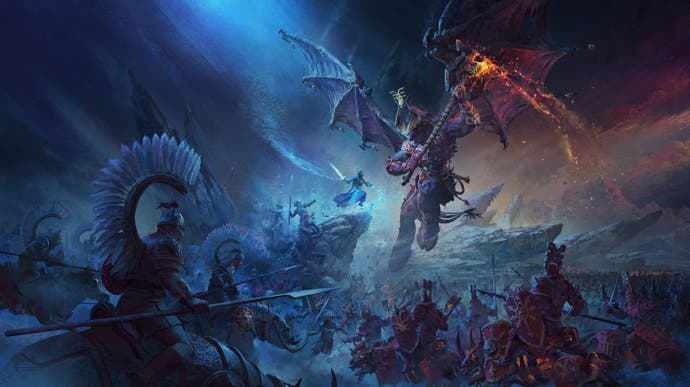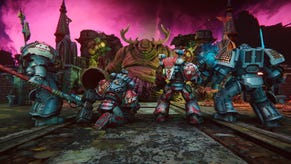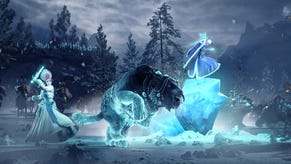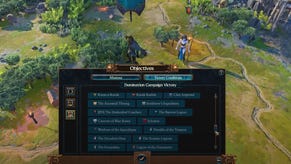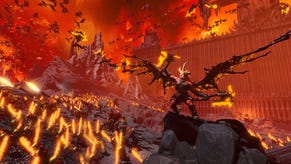Hands on with Total War: Warhammer 3's fiery new survival battles
Plus Creative Assembly on its plans for a "much bigger, badder, better experience all round."
Is there a more ridiculous faction in the world of fantasy Warhammer than Chaos? There probably is actually - this is Warhammer after all, land of sneaky rats and lizard folk. It is nothing if not broad. But none of those other myriad factions and races and creeds has the word "Nurgle" in it, does it? So Chaos wins.
Anyway, Total War: Warhammer 3. This is "the Chaos one", by the looks of things, featuring four different Chaos factions aligned to their respective gods: Khorne (the "blood for the blood god" one); Slaanesh (the naughty excess one); Tzeentch (the magic one); and yes, Nurgle, the god of looking like you'd smell absolutely disgusting.
Alongside these Chaos forces comes a couple of other new factions, Kislev and Grand Cathay, and a new kind of battle. In fact, there are several new types of battle, as we learned from talking to game director Ian Roxburgh ("more detail later" on those) but for now there's one headliner: survival battles, the boss fight-style mode that we've played for a good couple of hours, albeit streamed over an occasionally wobbly Parsec.
There are just four of these in the game's campaign, one for each Chaos boss that you'll need to defeat if playing as one of the typical "good guy" factions like those two new ones Kislev and Grand Cathay. Creative Assembly was very circumspect when it came to the details of how these are actually triggered in the campaign, but the answer from Roxburgh so far is that these are "kind of boss battles at the end of seminal gameplay moments within the realms - they are you completing that section, that requirement, in order to progress with the storyline."
Those four Chaos realms are actual locations that you'll visit with your armies in the campaign, he explained, describing them as "part of the experience when you play in the campaign game, and you will actually have gameplay in there as well," which marks a step beyond the Chaos Wastes that we saw in the first of the series. This is mostly gibberish to anyone unfamiliar with Warhammer and the Total War incarnations of it so far of course, but to fans it's pretty great. The first Total War: Warhammer game featured hordes of enemies flooding onto the campaign map from the Chaos realms, via the frosty, northern Chaos Wastes, and the second largely sidestepped it to focus on a more Eleven theme. Actually going there, to the home of the big baddies, is a real treat.
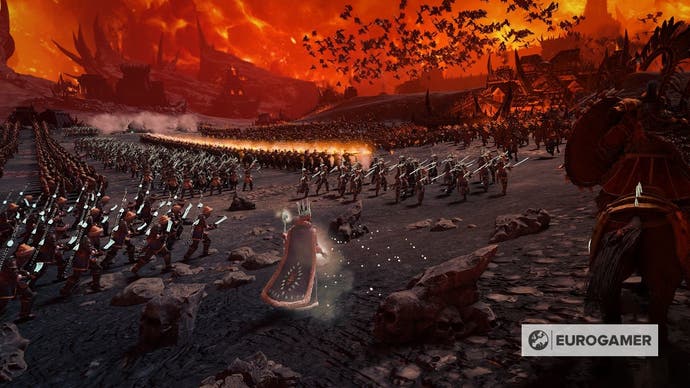
As for the goodies, their implementation has made for an interesting challenge. Kislev, an Eastern European- and Russian-inspired faction, occupies the role of 'foolishly overlooked last defence against bad guy invasion', and only had a relatively small number of units and background details fleshed out until now. Grand Cathay meanwhile was effectively little more than a name on a map, in the somewhat Orientalist role of 'mysterious faction from the East'. Turning them into full-sized playable factions has required a lot of back and forth with Warhammer license-holder Games Workshop, as a result. Creative Assembly's deft balancing of history and culture in Total War: Three Kingdoms does also leave the studio with some credit in the bank here, for when it comes to implementing Grand Cathay with the requisite care.
But what about these survival battles? Well, for Total War veterans they're something quite different. The setup is you, playing the role of Kislev in this case, have arrived at the Brass Citadel, Khorne's doorstep in his own Chaos realm. You bring your own army there, like you would when entering any other battle or siege from the campaign map, but one of the major twists is that you can reinforce from a set selection of troops as you go.
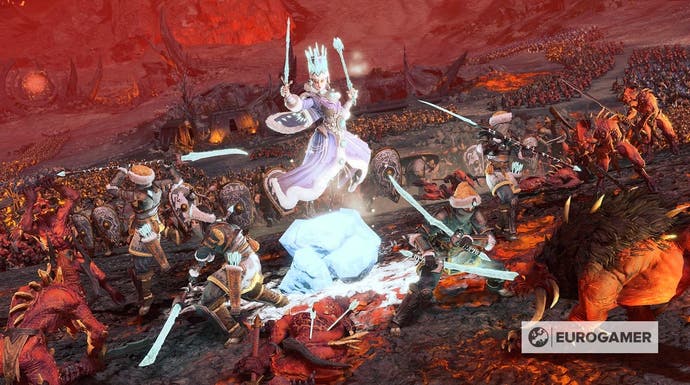
This is because survival battles are something of a multi-tiered horde mode. You start at one end of a long battlefield, and must capture several unfortified capture points as you go, one at a time. When you capture one, you get a lump of resources plus some resources earned over time, and a brief period of respite to buy fast-building defensive structures, before several more waves arrive from multiple directions. The structures aren't proper walls like in a siege, however - they're mostly barricades that your troops can climb over but not properly man in quite the same way as a traditional wall, alongside four kinds of missile towers. You can also only plant barricades in set positions, which don't cover the entire approach, so it becomes more about creating choke points and kill zones than a flat siege defence.
Enemies, meanwhile, are significantly weaker here in the Chaos Realms for the most part, to help create a sense of endless hordes to fight through, but they ramp up pretty quickly. By the final capture point I was facing multiple Bloodthirsters and heavily armoured Khorne warriors, all while flying units chipped away at my defences posted way back at the first capture point. If you're a player of average (at best) skill like myself, you'll find it noticeably more micro-intensive than standard Total War battles and sieges, and you'll likely need to rely quite heavily on your faction leader - in this case Kislev's ice queen, Tzarina Katarin Bokha - to spew out a fairly constant stream of area-of-effect magic to deff large groups of enemies.
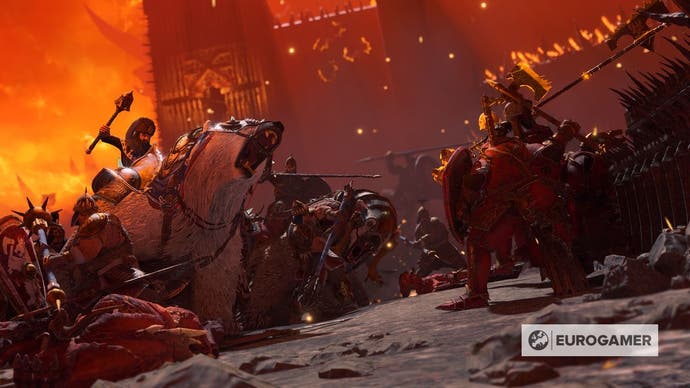
Kiting with fast units - which I never bother to get round to, the folding-your-underwear of battle tactics - becomes essential, in order to distract the latest wave of enemies from your dwindling forces. You'll also need to split some attention between the main fight at one end, and your once-captured command points at the others, as losing them can hurt your income and stop you from bringing new reinforcements, armour upgrades, or bursts of healing to your frontline.
There is a touch of gimmickry to these battles, I found, as is always the risk when you introduce a mode for such a limited four appearances. There's only so much depth that can be put behind its systems, so the building of structures and defences can feel a little one-dimensional next to the very heavy emphasis on micro-managing your troops through another step on the gauntlet. At the same time though, it was still good fun, and suitably epic in scale and tone, and will above all make for a nice twist from the standard battle formats of the campaign. They're intended as boss battles, after all, and although it's hard to get fully into something without the context of all the work you put in through a campaign, I can see them feeling thrilling in the real thing.
It's similarly tricky to really evaluate the new units, without the context of recruiting them or the time to learn them inside out, but Kiselv seem to mostly be about hybrid ranged and melee units. There are some with rifles, some more pure archers, and so on. The most exciting is the bear cavalry, two words which seem born to go next to one another, and an extremely powerful giant unit that is a big, frosty tank in the shape of Kiselv's own bear god. Using these to draw large clusters of enemy units and soak up damage while Katarin laid out some magic made for a great strategy, until I forgot to kite right at the end and got overwhelmed. The rest, if I'm being honest, failed to really stand out - but this is because of the sheer amount of things going on in this type of battle.
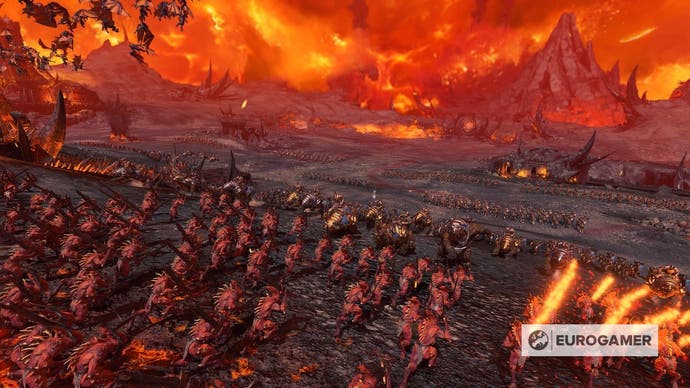
There are a few other little crumbs of detail we picked up from talking to Roxburgh: the super ultra mega map - the campaign map that stitches together the maps from all three Total War: Warhammer games - is still coming, thankfully, but it won't be there at launch. "The entire plan of breaking it out into a trilogy was to achieve this end," Roxburgh says, so it remains extremely important, but there are "a lot of technical challenges" to actually making it work. It will be free though and it will definitely come, which is how it ended up happening with Total War: Warhammer 2 after all.
Likewise, Roxburgh teased a little more about the other new kinds of battles we can expect. Minor settlement battles are coming, which will be different from major settlement sieges and normal battlefield battles ("you can attack from any angle") and are something the real Total War nerds have been after for some time. There's a new type of online battle called Domination Battles, which are "more about capturing areas and bringing in resources and enabling people who are maybe falling behind, rather than automatically being likely to lose because they've got a bad start, being able to pull the game back and potentially still win." And sieges themselves have been "reworked" quite significantly by the sounds of things too, bringing in some things the team has been keen to add for some time.
There's also the entirety of the campaign itself to reveal - the big, macguffiny mechanical twist that each of these games' campaigns has, and everything else that comes with it - and Roxburgh was very keen to emphasise the fact that the first two game's success have allowed them to plan a "much bigger, badder, better experience all round."
From the first taste of it, that certainly seems the plan. The survival battles are grandiose and a step up in terms of the stakes, the mechanical involvement, and just the length and scope of the battles themselves. If the rest of the game matches them, and the trajectory of the cracking previous two in the series, then we're in for a treat. And that's not even accounting for Nurgle.
